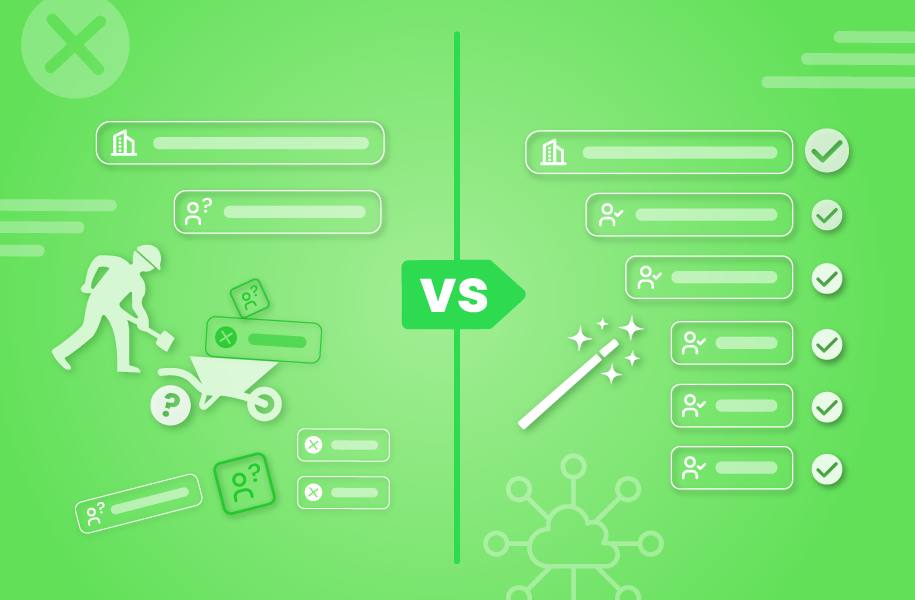How does your account-based selling stack up?
How do you stack up when it comes to your account-based selling (ABS) strategy?
As it turns out, three in 10 organizations are just starting their account-based selling journey. So as the strategy becomes more important for your business, where do you begin? And how do you excel?
The 2022 Account-Based Selling (ABS) Maturity Matrix stats are in, so let’s start from the top.
Here are the building blocks for ABS, the tools you need, and everything in between.
What is account-based selling?
Account-based selling is a selling strategy that focuses on one or a few high value accounts, as opposed to many. It involves multi-touch customer engagement across the entire buyer journey, which means a coordinated effort across sales, marketing, and customer success.
Since account-based selling requires the joint efforts of different departments, it’s crucial that the entire business is aligned and focusing on the same accounts. Gartner states this framework of thinking as account-based everything, and it’s critical to have a birds eye view across all departmental account-based initiatives.
Why should you focus on ABS?
20% of your existing customers will drive 80% of your organization’s future revenue.
Closing big deals is always a massive win. But it’s equally important to nurture strong customer relationships that provide a long-lasting return down the road.
This opens up opportunities to cross-sell and up-sell, expand across departments, and sell across the company hierarchy. Your products and solutions are then able to drive revenue from your targeted and strategic account-based approach.
When should you focus on ABS?
So when’s the best time to focus on account-based selling?
Not every organization uses this strategy and to answer this question, it’s best to look at your customers.
For example, a great indicator for account-based selling is if you sell to organizations that have more than 500 employees. Another good rule of thumb is if your average deal size with them is greater than $50,000.
Your company profile often matters less – what’s important is who you’re selling to and the nature of those deals.
Here are some other examples or indicators of when you should consider an account-based selling approach:
- The majority if your customers are enterprise-level (you aren’t selling to small- and mid-market)
- You sell subscription-based products that aren’t a one-and-done sale
- Your customers include companies or enterprises with a presence in multiple locations
- Your sales cycles are complex and tend to last three or more months
- You have or are planning to dedicate the resources and people power required to run an ABS strategy
- Your company has a Revenue Operations function or plans to add one in the next 12 months
In the B2B selling world, if you’re selling to enterprise companies you might focus on strategic accounts.
What’s a strategic account?
There are a number of ways to define a strategic account, but the underlying theme is this – these customers help your organization reach its overall goals. They build long-term retention and ultimately help expand revenue.
Two of the most common ways to define a strategic account are the size of the customer or how much revenue they generate. Other criteria include:
Other criteria can include:
- Product fit
- Growth potential
- Cultural fit
- Geographic alignment
- Potential partnership and relationship growth
How to develop an account-based selling plan
Just starting on your ABS journey? Take a walk, crawl, run approach.
Pro Tip: Start with 25% of your organization dedicated to your account-based team. From there, gradually increase the amount of teams you’re dedicating to this strategy.”
Create your Ideal Customer Profile (ICP)
Account-based selling starts with building an Ideal Customer Profile (ICP). An ICP is a set of benchmarks and details that outline what your company’s best or “ideal customers” might look like.
This creates a set of criteria that helps your company understand the best accounts to target down the road.
What kind of details are you looking for? There are a number of different factors to consider, including revenue, business size, industry, and geographic location.
And if you’re looking for a place to start, dive into your existing customers and look for any insights or data points that exist within your biggest buyers.
Build out specific buyer personas
Your ICP creates an understanding of the best accounts to target. Now, it’s time to dive deeper and use specific buyer personas to engage with the right contacts.
Buyer personas, similar to an ICP, can be built off specific criteria and existing customer data.
You can ask questions like:
- What kind of pain points do your best customers encounter?
- What kind of content does your ideal customer engage with?
- Which contacts within your best customers played a role in the decision-making process?
Having a buyer persona in place helps identify who decision makers at a target company are and the best way to engage and interact with them.
Build a list of companies and contacts that you want to target
With an ICP and specific buyer personas in place, revenue teams, sales, and marketing can quickly identify accounts with the largest potential for growth. Now it’s time to build a list of companies and contacts to target.
What’s important to recognize is that this process isn’t just about identifying your preferred targets – it’s also about eliminating accounts that aren’t the right fit or might not be profitable.
“The end goal of this process is about identifying and aligning your revenue team towards the highest value accounts,” says Sean Crowley, VP of Portfolio Marketing at Dun & Bradstreet. “Make sure to weed out targets that don’t fit or might not be profitable.”
Another pro tip is to use account hierarchies to uncover and sell across the entire family tree of a company.
Once you create results and foster a relationship with one company, you’ll have a much easier time getting your foot in the door with others – whether that’s simply securing an introduction or making another sale.
Build objectives in line with account-based marketing (ABM) efforts
Account-based marketing carries a lot of the same similarities as account-based selling.
For example, both strategies include creating an ICP and building out a buyer persona to better understand which contacts you want to target.
When it comes to ABM, however, the multi-touch customer engagement will include different forms of personalized content. This might include display ads, blogs, or social posts.
What’s important is making sure that the efforts of account-based sales and account-based marketing are aligned. ABM tactics need to bring in leads that are aligned with the same accounts that sales reps are working.
Why spend marketing efforts targeting a group of buyers that sales isn’t even aware of? In order for both of these strategies to succeed, both teams need the same shared objectives. Therefore, break down silos and bridge inbound and outbound efforts.
And if you’re wondering how to excel at ABM strategy, here are a few simple steps that all effective plans follow.
Set metrics of success and report on your efforts
You’re almost ready for your account-based selling journey! But before it gets underway, make sure to set some metrics of success.
You can’t just set it and forget it – it’s critical to measure the response, engagement, and progression of your ABS campaign.
Different measures that you can use include dollars sold, the number of accounts sold to, and products sold. You can also look at how many products have been sold within a family tree versus individual accounts.
Want to take your reporting to the next level? Ditch the spreadsheets and avoid wasting time trying to link parent-child accounts manually in order to understand your largest customers. Trying to connect accounts by hand can lead to disconnected hierarchies, muddied territories, and inaccurate reporting.
Take advantage of automated account hierarchies to link enterprise accounts together. Hierarchies will stay connected and up to date, plus you can take advantage of built-in tools like the whitespace feature and roll-up reporting.
Partner with best-in-class ABS tools
Now that your strategy is in place, your account-based selling journey is off to the races.
But if you’re looking to level up, here are some best-in-class ABS tools you definitely want to consider.
D&B Connect: D&B Connect is a customizable, self-service data management solution. With hundreds of millions of records, users have a single source of truth and can make smarter, risk-free decisions with data they can trust.
6sense: With the power of AI, 6sense helps companies uncover insights along every step of a potential buyer’s journey, prioritize accounts for sales and marketing, and even help nurture leads that aren’t ready to be handed off to sales.
Demandbase: Demandbase gives B2B businesses an array of sales and marketing tools that helps users better leverage the buyer journey. The company provides solutions for account-based engagement, advertising, smarter selling, and data insights.
Traction Complete: Not to tout our own horn but if you’re looking for a solution for your lead matching and routing, account hierarchies, or even data cleanup, we’ve got you covered. But don’t take our word for it – learn how our solutions have made a big impact for some of our largest customers.
Conclusion
When it comes to account-based selling, remember to walk before you run and to start with a gradual approach.
Setting measurable objectives and being able to coordinate efforts between departments are two major keys to success.
Want to find where your company stands, where the industry stacks up, or what you need to focus on to find ABS success?
You can learn more by checking out our Account-Based Selling Maturity Matrix.




